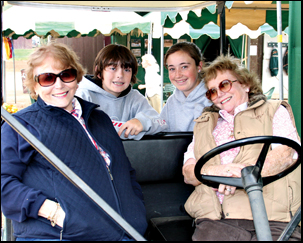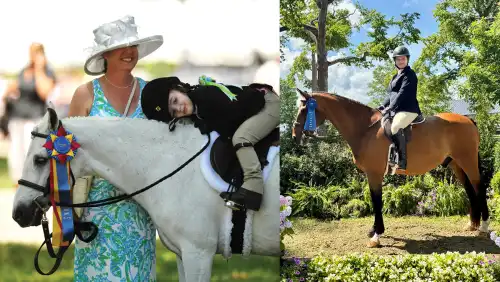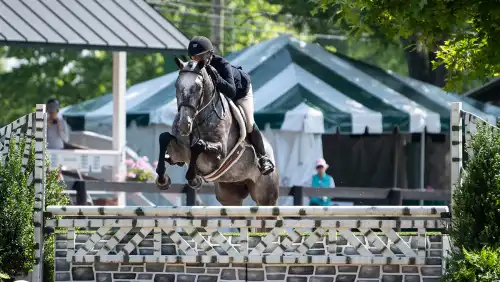Hannah Selleck and Jessie White win at this unusual competition that’s close to many California riders’ hearts.
Picture driving down a driveway lined with leafy, amber-tinged California oak trees, through which tantalizing glimpses of a cross-country course are visible. You arrive at a tidy green barn reminiscent of a fantasy Breyer horse stable, and when you look to your right there is a charming, stone-walled riding ring, filled with colorful jumps.
 This is the Foxfield Riding School and Camp in Westlake Village, Calif., and it is also the site of the Foxfield Jumping Derby.
This is the Foxfield Riding School and Camp in Westlake Village, Calif., and it is also the site of the Foxfield Jumping Derby.
The Derby takes place every October and this year’s Oct. 6-7, was its 28th renewal. The Derby boasts an impressive list of past competitors, including international grand prix riders Susie Hutchison, Hap Hansen, Rob Gage, Anne Kursinski, and Meredith Michaels-Beerbaum.
Twin sisters, Nancy Turrill and Joanne Postel, and Joanne’s husband Bill Postel
founded Foxfield 40 years ago. The original Robin Hood movie, starring Errol Flynn, was filmed on the site years before that, and a portion of the grounds is still referred to as “Sherwood Forest.”
The Foxfield Drill Team is world-renowned. They performed at the 1984 Los Angeles Olympics, the Devon Horse Show (Pa.), the National Horse Show back in its Madison Square Garden (N.Y.) day, the Rose Parade and many other prestigious venues.
The riders steer the horses through a series of choreographed routines all without a bridle or saddle. My California trainer, Meredith Bullock, who used to ride at Foxfield, remembered “riding around the field with nothing on my horse,” she said. “Or better yet, falling off her in the ‘wire class’ when, with my arms up shoulder height, she stopped so fast I flipped off.”
The Foxfield Derby consists of two sections. Junior and amateur riders compete in a morning section, over 3’6″ fences. In the afternoon, the fences are raised to 3’9″, the prize money increases, and the class is open to professionals.
Both classes run in a timed first jump-off format, with any clear rounds jumping off. The course starts in the stone-lined show-jumping ring, until the riders jump out of the ring and continue out on the cross-country course to jump various natural obstacles. Then, riders jump a bank back into the show-jumping ring, where they complete their course with traditional show jumps.
The natural jumps on the cross-country portion include a bank-ditch-table combination, an open water, a sunken road, and assorted liverpools and ditches. It is a challenging course totaling 22 obstacles, and Foxfield prohibits riders from practicing over the course for the several weeks leading up to the Derby.
They Must Be Brave
ADVERTISEMENT
In 2005, when I was 12, I rode in the Derby and was one of the youngest riders. Foxfield welcomes and encourages young riders. I practiced for months in advance, at home, because my horse Houdini had never been in a Derby and had an aversion to water.
It was truly a triumphant moment when we sailed over the open water, as a team. I did have to growl at him to get the job done, but it was definitely a confidence building experience.
Legendary California grand prix rider Susie Hutchison “won the Derby five times—once with Samsung Woodstock, when he first arrived in this country,” Hutchison said.
“Some of our horses had never seen some of the obstacles and never would again, so if we were unsuccessful with the sunken road or something unusual like that, it was no big deal to the overall career of the horse,” she added. “For a Derby, the horses must be brave, in a different way than a normal grand prix horse. They can’t spook at anything—they need to just go. They must also be fitter than
the normal grand prix horse as the course is generally longer.”
Course designer and judge Rob Gage said that in the late 90s, he brought a number of students to the Derby. “As the class progressed, I felt nobody could beat my riders. Then along came some local girl I had never seen before and rode the jump-off so fast that she won the class. My riders ended up second, third, and fourth,” he recalled.
That rider was Holly Zimmerman (now Holly Scapa) on one of Foxfield’s own horses. Scapa is now a grand prix rider.
The NBC television network used to televise the Derby. “It was one of the first equestrian events to have great TV coverage. The television exposure is just good for any sport and draws people in,” Hutchison said.
Trainer Kathy Megla recalled, with a mischievous laugh, that it was a big deal when NBC televised the Derby. “They miked rider Rob Gage, so that he could narrate as he was jumping the course. To the viewers it sounded a little like an R-rated movie, complete with heavy breathing and snippets such as ‘You can do it baby, come on that’s right, faster now.’ ”
One Big Family
This year, junior rider Hannah Selleck won the morning Derby on Circa Z. Selleck, in her last junior year, was proud of her horse, as he has recently returned to competition after being gelded. Circa Z is Nicole Shahinian Simpson’s former World Equestrian Games and World Cup Final mount.
“Foxfield is such a special place because that is where I began riding at age 4 and rode for 10 years after that,” Selleck said. “The people there are so loving and kind it becomes one huge family. Nancy and Joanne are very nurturing and great teachers, not only of riding but also of character.”
Selleck enjoyed the challenges of the different kinds of jumps in the Derby. “It helps to prepare horses and riders for other events with natural obstacles, such as the USEF Show Jumping Talent Search class. It’s always good to have a course where you actually have to ride and not just look good doing it because when riders get too stuck being ‘pose-y’ they are not effective,” Selleck said.
ADVERTISEMENT
Foxfield alum Jessie White won the afternoon session, which was open to professionals. With her longtime partner Another Cat she beat Scapa and Georgy Maskrey-Segesman (both Foxfield alums as well) in an exciting jump-off.
“This was my eighth Foxfield Derby on [Another Cat] and he was amazing once again,” White said. “The course is always demanding but not too difficult if you ride each fence carefully.”
Varying Success
Several riders from the West Los Angeles community riding ring where I train competed in the Derby. Amongst them is Mary Sweeney, a successful restauranteur, Baby DeSelliers, a bohemian painter, Ella Cornell, a high school student recently returned from two years of study abroad, and Kathy Megla and Meredith Bullock, both trainers and alums of Foxfield.
Megla rode a client’s horse in the Derby, and Bullock coached one of her students. They all practiced for weeks, paying particular attention to the bank-ditch combination and the open water. The sunken road is tough to recreate.
Bullock hoped that her students came away from the event proud of their efforts and their horse’s efforts. “I hope they come back even more confident than they left and a little smarter too,” she said.
DeSelliers enjoyed the friendly atmosphere of the Derby. “You get to watch and admire other riders and experience a more old-fashioned, go-for-it type of riding,” said DeSelliers.
Of my four friends from my community riding ring, Cornell, the junior finished fourth in the morning session. Unfortunately, Sweeney and DeSelliers, the adult amateurs, both had unexpected dismounts at the water element.
Megla made it over the water, but was subsequently disqualified when the officials determined that her horse had actually landed in the flowerbed to one side of the water instead of within the required zone. When this happens the rider is considered to be off course.
The results from the morning were disappointing—of 28 entries, 16 were disqualified, and nine fell off. “When the first three riders all fell off, many of the riders got a bit more nervous,” Bullock said. “Some of them over-rode and some under-rode, but either way it did not lead to success.”
Zazou Hoffman














